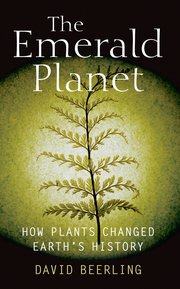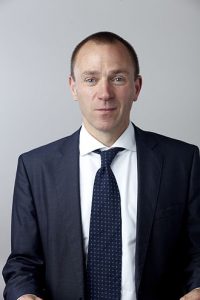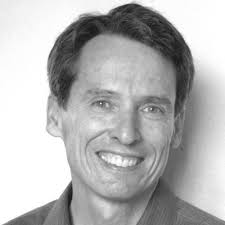Can we really power civilization with just hydro, solar and wind power? Scientist Ken Caldeira says almost, but not quite, in a new study. But we’ve already dumped too many greenhouse gases into the atmosphere. From the UK, scientist David Beerling explains a big new solution: laying down carbon-grabbing rock as fertilizer in the world’s fields. James Hansen is a co-author. Environmental journalist Stephen Leahy reports the good and bad news as cities lead the way. This is Radio Ecoshock. Welcome aboard.
Listen to or download this Radio Ecoshock show in CD Quality (57 MB) or Lo-Fi (14 MB)
KEN CALDEIRA: THE PHYSICAL LIMITS OF ALTERNATIVE ENERGY IN THE UNITED STATES
Is the dream of a civilization powered by the wind, sun, and water just that – a dream that cannot become a reality? Our guest Ken Caldeira argues that solar and wind power can take us a long way, but not all the way. That scientific argument has spilled out of the journals and into social media, blogs, and the law courts.
Dr. Caldeira is one of the most famous and respected atmospheric scientists in the world. His home base is the Carnegie Institution for Science, in the Department of Global Ecology. Ken has published ground-breaking papers on ocean acidification, geoengineering, and near-zero-emissions. He co-authored key papers for the Intergovernmental Panel on Climate Change and the U.S. National Academy of Sciences.

Dr. Ken Caldeira
Listen to or download this 26 minute Radio Ecoshock interview with Ken Caldeira in CD Quality or Lo-Fi
We are here to talk about the paper “Geophysical constraints on the reliability of solar and wind power in the United States.” The lead author is Matthew R. Shaner and Ken Caldeira is a co-author. Another co-author is Stephen J. Davis UC Irvine, who I interviewed for the show January 30, 2013. We talked about re-assessing the “wedge” theory, and why it is already too late for that.
You can listen to that interview with Steven J. Davis, Assistant Professor Department of Earth System Science, University of California, Irvine
MIT Professor Mark Z. Jacobson published a paper in December 2015, outlining how the United States could power up with just wind, water, and solar. The title is “Low-cost solution to the grid reliability problem with 100% penetration of intermittent wind, water, and solar for all purposes“, PNAS.
Two years later, Caldeira along with others, including lead author Christopher Clack, issued a very negative rebuttal paper, also in the Proceedings of the National Academy of Sciences. That paper is “Evaluation of a proposal for reliable low-cost grid power with 100% wind, water, and solar”, PNAS, February 24, 2017. You can read the full text here.
Mark Jacobson pushed back with this article, published in the same issue of PNAS: “The United States can keep the grid stable at low cost with 100% clean, renewable energy in all sectors despite inaccurate claims”
Jacobson appears to have taken criticism of his model as an insult to his science. In a move very unusual for debate in science, Jacobson sued C. Clack and the National Academy . That suit was dropped this year. You can read Mark’s Tweet about the lawsuit ending here, and his full statement here. To dig into this further, Mark says “a total of 30 peer-reviewed scientific papers located at [here at Stanford] support the contention that the grid can stay stable with 100% or near 100% renewable energy.”
This Jacobson lawsuit sent a chill into some scientists wanting to add to this debate. You can read all about these “fisticuffs” here in the New York Times. It came to the point where one article rebutting Jacobson was passed on to Ken Caldeira, because the author worried about being sued. Caldeira published that article in his blog.
In November of 2014, Mark Jacobson described his plan for all-green power here on Radio Ecoshock. But he did not talk about his heavy reliance on a projected renaissance of hydro electric power. The problem is that Jacobson’s plan assumed nearly ten fold increase in hydro power, much of it by adding more generators to existing dams. You can find Ken Caldeira’s criticism of that hydro reliance here.
To my mind, the main point of the new paper by Caldeira and team is: we can get 80% of our electric needs from solar, hydro, and wind power (if a low-loss national grid is built for America). That is a lot! But that last 20% would be very, very expensive, if we try it with just hydro, wind, and solar. It would require giant storage capabilities, and some of the peak power units would be used rarely, in the few times when peak power is needed.
I did ask why we can’t just cut back our electric needs to that 80% of current, and just alternative energy. You’ll have to listen to the interview to get that answer. I personally think our civilization, if it wants to survive it’s own energy system, will have to become more flexible. We may go to work when clean energy is available, and stay home when it isn’t. Perhaps industrial production at night will not be possible, unless there is enough wind blowing. We adapt to what sustainable energy can provide.
Most critics assume Jacobson was being unreal by including a deployment of energy storage on a grand scale. But what about the mega-storage projects being installed in Australia already by Elon Musk’s company? What about the mega-storage slated to be built by Statoil.
In this article at Greentech Media, energy storage specialist Matthew Klippenstein writes:
“The Norwegian energy firm plans to deploy an onshore 1 megawatt-hour lithium-ion battery system (“Batwind”) in late 2018, to evaluate the potential for energy storage to complement the offshore wind technology.”
So maybe large scale storage will come quicker and bigger than thought?
Another key problem: this new paper by Shaner, Caldeira et al. mentions emergency needs for power. Assuming climate change leads to more and more extreme weather events, drought that could reduce hydro power, fires that can wipe out transmission lines – how does climate change itself feed back into the demand for electricity?
Proponents of nuclear power are leaping to Caldeira’s defense, and attacking Mark Jacobson. One reply to Caldeira’s Tweet proposes running the whole world on nuclear power.
This new paper is about how much of the grid can be supplied by solar and wind in the United States. A new study just came out evaluating the same question in the UK, and they got very similar results. Caldeira Tweeted “Evaluation of 100% renewable electricity scenario for the UK finds that meeting the last bits of load get very expensive. (VOLL = Value Of Lost Load)”
The referenced source is: “Real-World Challenges with a Rapid Transition to 100% Renewable Power Systems”
Clara Franziska Heuberger, Niall Mac Dowell.
HERE IS A BIT MORE FROM CALDEIRA’S BLOG POST “EXPLAINER” OF THE NEW PAPER
Geophysical constraints on the reliability of solar and wind power in the United States
Posted on 1 March 2018 by kencaldeira
Geophysical constraints on the reliability of solar and wind power in the United States
“Our main conclusion is that geophysically-forced variability in wind and solar generation means that the amount of electricity demand satisfied using wind and solar resources is fairly linear up to about 80% of annually averaged electricity demand, but that beyond this level of penetration the amount of added wind and solar generation capacity or the amount of electricity storage needed would rise sharply.”
“Obviously, people have addressed this problem with more complete models. Notable examples are the NREL Renewable Electricity Futures Study and another is the NOAA study (McDonald, Clack et al., 2016).
These studies have concluded that it would be possible to eliminate about 80% of emissions from the U.S. electric sector using grid-inter-connected wind and solar power. In contrast, other studies (e.g., Jacobson et al, 2015) have concluded that far deeper penetration of intermittent renewables was feasible.”
DAVID BEERLING: ROCK DUST TO CAPTURE CO2 AND FERTILIZE FIELDS
Currently, we are headed for horrible climate change, or maybe climate catastrophe. Decades ago, we could have saved ourselves by stopping the use of fossil fuels. Now, even rapid decarbonization is not enough. Somehow, we have to recapture our previous emissions and store them safely away from the atmosphere.
Some drastic geoengineering plans have been suggested, including darkening the sun with more pollution. A new paper investigates a less harmful way to capture carbon AND help crop production at the same time. It has the blessing of James Hansen. In fact, Hansen is an active co-author in this new paper.
From the University of Sheffield UK, we have reached the lead author, Dr. David J. Beerling. He is a Professor of Natural Sciences and Director of the Leverhulme Centre for Climate Change Mitigation. Beerling is author of 200 papers, and the best-selling book “The Emerald Planet: How plants changed Earth’s history”. We will be talking about a big new paper titled “Farming with crops and rocks to address global climate, food and soil security“.


Professor David Beerling
Listen to or download this 23 minute Radio Ecoshock interview with David Beerling in CD Quality or Lo-Fi
The paper investigates a technique called “enhanced weathering“. All through history, certain types of rocks have slowly captured carbon from the atmosphere. In fact, it is thought this is the major process which, over millions of years, cools Earth after a major heating period. To use if in any meaningful way to reduce atmospheric carbon now, we would have to speed it up.
It would require a massive project. Carbon-needy rock needs to be quarried or mined, ground up into dust, transported to agricultural areas, and then spread on farmers’ fields.
Farmers already spread many things, from lime to fertilizer. Rock dust acts as a kind of fertilizer, and may replace other fertilizers that depend on fossil fuels. Organic farmers already add rock dust to their gardens and fields. I do it in my own garden. Rock dust is also known to inhibit some insect damage, or at least make plants more resistant to insects.
One article looks at this new science, and sees it as proof of how unattainable such a scheme could be. An earlier paper by Phil Renforth in Britain did a rough calculation of the economic cost of establishing such a vast new industry. Beerling and his team are currently doing another study on that. We also need to calculate the carbon costs of the mining, transport, and distribution, to be sure that more carbon is being captured that expended. It is early days for this proposal.
[Renforth, P. (2012). “The potential of enhanced weathering in the UK“. International Journal of Greenhouse Gas Control. 10: 229–43. doi:10.1016/j.ijggc.2012.06.011.]
But as a botanist, Beerling is even more concerned about how we are going to feed the billions of new humans arriving on the planet in coming years. The rock dust industry may be as much about helping to feed humanity, and keep our fields fertile, as capture carbon dioxide.
Even so, the new paper by Beerling and his team says:
“Effectively, nearly 11% of the terrestrial surface is managed for crop production and this may offer an opportunity to deploy a means of carbon sequestration at scale within a decade or two.”
CITIES LEAD IN CLIMATE FIGHT: STEPHEN LEAHY
We just had a few minutes at the end of this program to talk with a long-standing environmental journalist, Canada’s Stephen Leahy. Stephen’s just published a key article in National Geographic:
“Cities Emit 60% More Carbon Than Thought
A new analysis finds that city planners have been undercounting greenhouse gas emissions from a key contributor.”

Environmental Journalist Stephen Leahy
When cities add up their carbon emissions they tend to look at automobile traffic, factories, and all that happens within their city limits. But most of the materials purchased by city dwellers are produced somewhere else. It is normal for cities in India to be polluted, partly making produces to sell in New York, Dresden, and all cities. We ask why cities in China don’t control their air pollution and carbon emissions, while we go shopping for produces that include those emissions.
But in the meantime, cities that are taking the lead on climate change, need to add in the emissions from consumer products. And by the way, there is no way to get to zero emissions with low-carbon buildings and mass transit, while we continue the consumer culture. Billy Talen and the Church of Stop Shopping are badly needed if we want to survive climate change!
Listen to or download this 8 minute Radio Ecoshock interview with Stephen Leahy in CD Quality
—————
COMMENTS AND NOTES FROM ALEX
In this program, we looked at one big way to capture carbon dioxide from the atmosphere, spreading rock dust on agricultural fields. But that won’t stop the sea level rise we’ve already set in motion, which will be 2 meters, or 6 and a half feet higher by the year 2300. That floods out big sea-side cities, most of the state of Florida, and important crop-growing deltas in many parts of the world.
But what if we could store the excess sea water back up on the ice? Scientists from the Potsdam Institute have investigated what we need to capture each year’s sea level rise, and stack it on Antarctica, where it would remain for a thousand years or so. To run the pumps we just need seven percent of the world’s energy production, in a place where there is no energy production. No worries. We just need to install 850,000 wind turbines around Antarctica, where there is lots of wind. Plus run the world’s largest pumping stations and 700 miles of pipelines in Earth’s coldest climate.
The 3 scientists, including our recent guest Dr. Anders Levermann, are not making a serious proposal. They are shining a spotlight on sea level rise, and the fact that we are not going to fix it with anything other than withdrawing from the changing coastlines all over the world. The paper was published March 10 in the open access journal “Earth Systems Dynamics”.
Delaying future sea-level rise by storing water in Antarctica
K. Frieler1, M. Mengel1, and A. Levermann
Potsdam Institute for Climate Impact Research, Potsdam, Germany
There’s a good article about all this by Chris Mooney at the Washington Post here.
COMING UP
A couple of weeks ago it was hotter at the northern-most tip of Greenland than it was in London England. Next week we are going to talk about yet another big shift in the Arctic. I’ll be talking with Mark Serreze from the National Snow and Ice Data Center. But we’ll get outside the institutions, to hear from two arctic activists who are ringing every alarm bell they can find. They strange weather you have been living through, they say, comes from that Arctic change. And that’s only just the start.
Now over 20,000 world scientists have signed a warning begun just last November by our Radio Ecoshock guest Dr. William Ripple from Oregon. They write:
“Soon it will be too late to shift course away from our failing trajectory, and time is running out. We must recognize, in our day-to-day lives and in our governing institutions, that Earth with all its life is our only home.”
We are out of time for this week. Please join us again, and support the “More Radio Ecoshock” campaign. Thank you for listening.
hydro is a major methane source,
wind turbines use 100 X more copper than fossils
offshore turbines use 1000 X more copper
2010 copper ore grades were 30 lbs/ton of rock
2016 coppor ore grads were 3 lbs/ton of rock
solar and wind products last 30 years tops
100% energy transitions take 70 minimum
solar and wind break down 2X faster than we can tranistion
Stefan Rahmstorf says our emissions must go down 100% in 20 years to stay under 2 C.
James Hansen says 2 C = DISASTER
Kevin Anderson says we have a 5% chance of success for staying below 2 C.
We have a 95% chance of failing to stay below the disaster zone.
Energy Prospects
UC Davis Peer Reviewed Study: It Will Take 131 Years to Replace Oil with Alternatives (Malyshkina, 2010)
http://pubs.acs.org/doi/abs/10.1021/es100730q
At this rate, it’s going to take nearly 400 years to transform the energy system
https://www.technologyreview.com/s/610457/at-this-rate-its-going-to-take-nearly-400-years-to-transform-the-energy-system/
University of Chicago Peer Reviewed Study: predicts world economy unlikely to stop relying on fossil fuels (Covert, 2016)
https://www.aeaweb.org/articles?id=10.1257/jep.30.1.117
Solar and Wind produced less than one percent of total world energy in 2016 – IEA WEO 2017
https://www.iea.org/publications/freepublications/publication/KeyWorld2017.pdf
Fossil Fuel Share of Global Energy since 1990 – BP 2017
https://imgur.com/k7VecMq
Renewable energy ‘simply won’t work’: Top Google engineers
http://www.theregister.co.uk/2014/11/21/renewable_energy_simply_wont_work_google_renewables_engineers/
Top scientists show why powering US using 100 percent renewable energy is a delusional fantasy
http://energyskeptic.com/2017/big-fight-21-top-scientists-show-why-jacobson-and-delucchis-renewable-scheme-is-a-delusional-fantasy/
IEA Sees No Peak Oil Demand ‘Any Time Soon’
https://www.wsj.com/articles/iea-sees-no-peak-oil-demand-any-time-soon-1488816002
The Curse of Energy Efficiency
https://thetyee.ca/Opinion/2018/02/26/Energy-Efficiency-Curse/
Pingback: To March 31st CLIMATE and nuclear news | Nuclear Australia